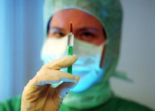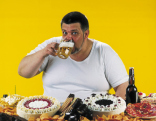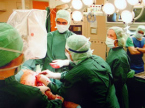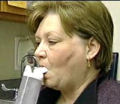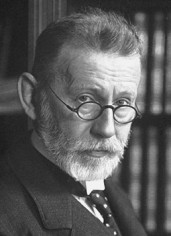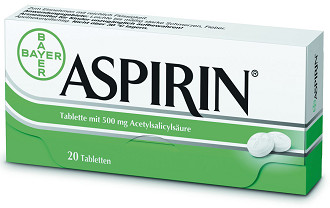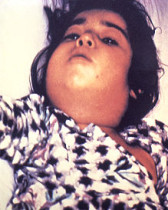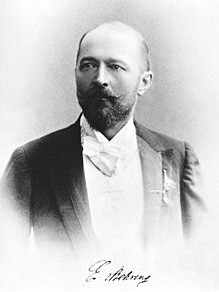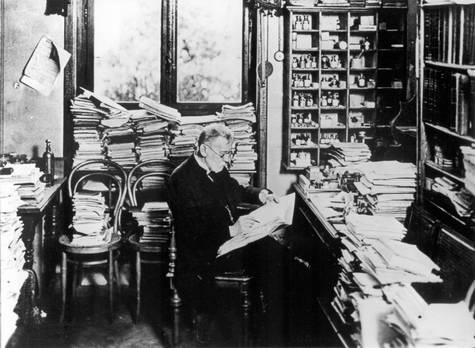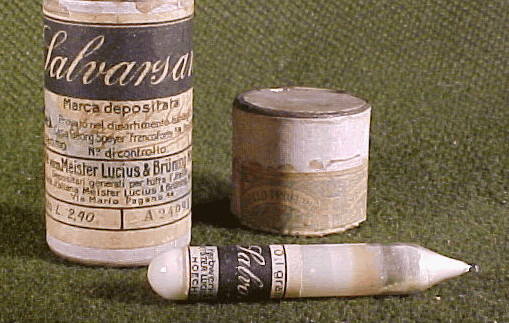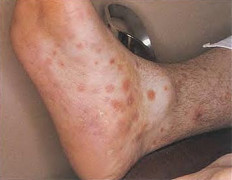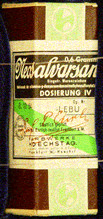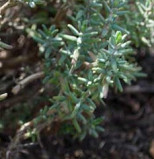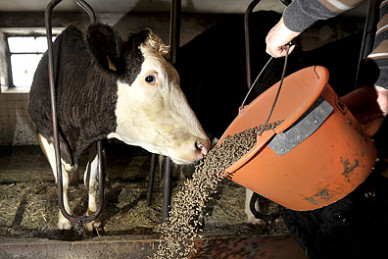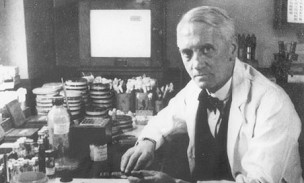|
|
|
Lies and profit with "normal medicine" (part 3)
How medicine after the invention of radiation equipment was driving to the wrong "side" -
profit strategies in medicine business7. Industry fighting for medical research since 1900 appr. - career of Paul Ehrlich
8. Ehrlich finds remedies against sleeping sickness and syphilis - Hoechst invents the instruction leaflet in 1912
9. Antibiotics and over prescription with antibiotics - resistances of bacteria - allergies by too many antibiotics
10. Research for disinfecting agents: Alexander Fleming finds, Florey and Chain are producing Penicillin
Normal "medicine" is making faked propaganda stating that their "pills" would help, but at the same time more illnesses are caused...
by Michael Palomino (2004 / 2005 / 2009 / 2012)
| Teilen
/ share: |
Facebook |
|
Twitter |
|
|
|
from:
Langbein, Kurt / Ehgartner, Bert: The Medicine Cartel. 7 Lethal Sins of Health Industry (orig. German: Das Medizinkartell. Die 7 Todsünden der Gesundheitsindustrie); Piper edition, Munich 2002; summary and chronology by Michael Palomino
Comment
All occasional inventions are indicated as "occasional". The lies in normal "medicine" are precisely presented in a chronology and with the argument chains. In normal "medicine" the factor making career and money is more important than the health of the human. Why do the health insurances pay for this normal "medicine" when there are always more ill persons produced instead of healthy persons?
Michael Palomino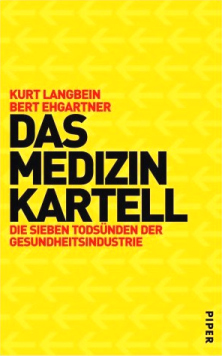
Abbreviations BMJ British Medical Journal (p.276) NIH "US" National Institutes of Health with headquarters in Bethesda, Maryland (p.324) JAMA Journal of the American Medical Association (p.339) RAC Recombinant DNA Advisory Committee (p.328) Chapters
7. Industry fighting for medical research since 1900 appr. - career of Paul Ehrlich
8. Ehrlich finds remedies against sleeping sickness and syphilis - Hoechst invents the instruction leaflet in 1912
9. Antibiotics and over prescription with antibiotics - resistances of bacteria - allergies by too many antibiotics
10. Research for disinfecting agents: Alexander Fleming finds, Florey and Chain are producing Penicillin
7.
Industry fighting for medical research since 1900 appr. - career of Paul Ehrlich
Since 1900 appr. Color Industries are developing into Pharma "Industries" with only one aim: to kill bacteria and germs. In this manner also other medical sectors are developing as if there would be a chemical war. One can compare this medical research with a carpet bombing against bacteria and germs (p.79). And the wrong thesis of Koch and Pasteur [that only bodies without bacteria and without germs would be good bodies] are provoking a lethal logic thinking within the new "industries":
The more lethal a pathogen is, the more dangerous has to be the therapy (p.80).
Bayer and Hoechst in Germany are the principle color industries in a big competition (p.80).
Paul Ehrlich: color researcher at Koch Institute, infecting himself with TB pathogens but his TB remains without outbreak
As a youth Paul Ehrlich learns from a familiar member, a pathologist, how cells can be colors for a better identification. Colors get his ambition. He detects the white blood cells and the lymphocytes, and also the mast cells. Ehrlich also performed animal tests with mice, guinea pigs and rabbits testing the malaria pathogen and the pathogen of sleeping sickness: Color is injected as a counter agent so there are colored rabbits, but no healthy rabbits (p.80).
Paul Ehrlich, portrait of 1910 appr. [1]
Ehrlich also has subscribed to the specialized review "Reimann's Coloring News" ("Reimannsche Färberzeitung") (p.80-81). He is working in Robert Koch laboratories with TB pathogen and infecting himself with it. Ehrlich has got the idea of a chemotherapy, is touring and curing in Egypt, and in 1890 he gets Koch's tuberculin, but fortunately this tuberculin remains without effect - and the illness also remains without outbreak (p.81).
1897 appr.
Hoechst, Bayer and Aspirin
Felix Hoffmann working with Hoechst is isolating Acetic Acid from willow bark producing Aspirin pills with it. This is nothing sensational because willow bark is well used in the population of these times as a remedy against pains. Now, Aspirin is the angle for Bayer getting a world wide medical enterprise spreading this drug [one could also take a willow bark tea] (p.82).
Package of Aspirin from Bayer [2]. A simple part of willow bark was isolated and sold as a "medicament", and there are heavy side effects.
1898
Ehrlich becoming a doctor of "Royal Institute for Standardizations in Serum Therapies" in Francfort
and Hoechst plants are just nearby (p.81). Ehrlich is well charged leading soon two institutes in Francfort:
-- for cancer research
-- and for experiments with chemotherapy (p.82).
Ehrlich and Behring are developing at the same time a remedy against diphtheria by immunization of horses (p.82).
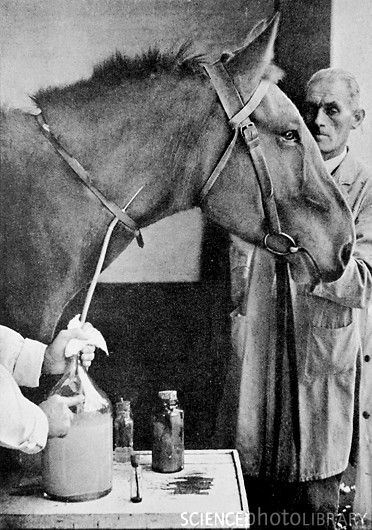
Serum against diphtheria was won first with horse blood [3]
<Diphtheria antitoxin. Inoculated horse having blood taken from its exterior jugular vein, which will be used to treat diphtheria. Diphtheria is an acute infectious disease caused by the bacterium Corynebacterium diphtheriae, which produces toxins that damage nerves and heart muscle. In 1890, Emil von Behring discovered that horses inoculated with C. diphtheriae produced antitoxins (antibodies). Administration of horse blood serum to people with diphtheria neutralized the bacterial toxins and cleared the infection. Today, use of horse-derived antitoxins is less common, as most children are immunized against the disease.> [web01]
1900 appr.
Diphtheria
Diphtheria is an infection of the higher respiratory tract with a "gram positive" "corynebacteria diphtheria". The pathogen is segregating the exotoxin "diphtherietoxin" and this exotoxin can provoke life endangering complications and after-effects. The name comes from Pierre Fidèle Bretonneau (diphthéra=leather rolls, brown swelling of the neck). In the middle ages there were other names for this like croup. The transmission is performed with droplets or with smear infections. Transmitters can be sneezing, coughing or kissing, or also the common use of objects. The poisons of the pathogen are damaging the protein biosynthesis hindering the elongation factor. The blood is transporting this poison into all organs, so life threatening complications can be possible. Emil von Behring could develop a passive vaccination with serum. Gaston Ramon introduced an active vaccination with diphtherietoxoid. But when not all children get a vaccination diphtheria is reappearing again (this was the case for example after the breakdown of the Soviet Union in some parts of Russia).
Girl with swollen neck by diphtheria [4]
Depending on the situation of the immune system the symptoms can be differently strong. One can differ different kinds:
1. Tonsil and throat diphtheria: symptoms are exhaustion, sickness, swallow pains, often also belly aches, pain in the limbs, increasing fever, rarely vomiting
2. Nose diphtheria: symptoms are a blocked nose above all with babies and little children, unrest, troubled food intake, head cold until there is a purulent and bloody cold, often with a destruction of the tissue forming slough at the entrance of the nose
3. Larynx diphtheria: is often followed after a throat diphtheria with loud cough, increasing huskiness, loosing the voice (aphonia), heavy breathing with whistling noise (stridor) corresponding to a "real croup"
4. skin diphtheria (rare): symptoms are ulcers and injuries
5. diphtheria of conjunctiva: symptoms are a bloody watery segregation and membrane forming, and often also cornea is affected; eventually the forming of membrane is spreading also on the tonsils, palate, uvula and nasal mucosa, accompanied by swollen lymph nodes.
Complications can be:
-- myocarditis (inflammation of the heart muscle with trouble of stimulation redirection, enlargement of the heart, circulatory collapse, "early death" in the first weeks or "late death" during convalescence)
-- polyneuritis (nerve inflammation with paralyzation of different nerves resp. different nerve branches of the brain making possible several paralyzations: of the velum, of the eye muscles, there can be troubles in swallowing, or paralyzations of swallowing)
-- pneumonia (pneumonia happens in 50% of the lethal diphtheria cases)
rarer are:
-- nephritis (restricted kidney functions, kidney failure)
-- bacteremia
-- endocarditis
-- pulmonary embolism
-- encephalitis.
A first test of nowadays is possible after an incubation time of 12 hours, and then there should be an immediate beginning of therapy with antidote serum (antitoxin) binding and neutralizing the poisons. A cure with penicillin (at least for 10 days) is killing the bacteria. Eventually an artificial access to the windpipe has to be created. Bed rest is preventing a harm of the heart [web02].
Emil von Behring stealing the diphtheria remedy
Behring's propaganda claims that he alone had found the immunization of the horses winning the antidote against diphtheria. Behring devaluates Ehrlich's help and Behring claims he would be the only inventor (p.82).
Emil von Behring, portrait [5]. He did it like Pasteur, robbed the invention and let defame the colleague...
1901
First Nobel Prize of Behring - Hoechst contracting Behring - "Behring plant"
For his diphtheria medicine Behring gets the Nobel Prize for medicine, and Behring is converted in a noble (p.82). Hoechst is contracting Behring with a diphtheria agreement. Behring is installing an own production in Marburg, with vaccinated horses etc., from 1904 on called "Behring plant" (p.83).
8.
Paul Ehrlich finds remedies against sleeping sickness and syphilis - Hoechst invents the instruction leaflet in 1912
Paul Ehrlich is investigating in his own way looking for a method applying colors. The aim is a non toxic chemotherapy finding antidotes against bacteria which principally don't harm the body. Well,
-- Ehrlich's animal experiments are ending in a disaster, for example with methylene blue: All animals are blue and die
-- then another experiment is following with the agent atoxyl as an agent against sleeping sickness. The agent contains arsenic provoking sometimes a blindness with human beings and is not a success either (p.83)
-- then Paul Ehrlich is injecting more colors to the animals against sleeping sickness with variations of arsenic combinations (p.84).
1909
Ehrlich's research: E606 against sleeping sickness and syphilis
After 605 attempts without success with animals he is probing the arsenic lotion "E 606" [that is: "Ehrlich 606"]:
-- and now the parasite is killed, and the mouse survives
-- but sleeping sickness is hardly known in Europe so Ehrlich considers that the pathogen also could have an effect against syphilis
-- and the new experiments are successful (p.84), and syphilis which was only treated with a mercury lotion before provoking heavy intoxications as side effects has got a new remedy: E 606 (p.84-85).
Hoechst takes this new E606 from Ehrlich producing it under the name of "Salvarsan" before having probed any human being with it (p.84).
Paul Ehrlich in his workroom in 1900 [6]
Salvarsan from Hoechst [7]
In autumn 1909 Salvarsan is probed with 23 syphilis suspected persons with "lower intelligence":
-- some of the affected show fast improvement of their symptoms
-- 1,000 patients are treated and partially there are striking cure successes
-- but the application is difficult: The arsenobenzol lotion has to be dissolved in sterile water. Distilled water is not sufficient because in only distilled water Salvarsan is oxidating and is becoming more toxic (p.85).
In 1910 Ehrlich authorizes the sale of Salvarsan, and there is an enormous demand (p.84). Hoechst has ensured the bestseller and the monopoly counts until 1914 (p.85).
But now unfortunately there are claims against Salvarsan because of heavy side effects of "Salvarsan":
Syphilis
Syphilis is transmitted by mucosal contact by the bacteria "Treponema pallidum spp.pallidum". Symptoms are ulcerations of the mucosa and swollen lymph nodes, and when it's chronic so the ulcerations are on the skin and on the organs until the central nervous system can be destroyed. Antibiotics and penicillin are the mane cures, but they loose more and more their force because the pathogens build resistances against the antibiotics.
A pregnant woman can transmit syphilis on the new born baby [web03].
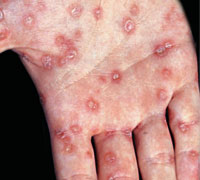
Syphilis ulcerations on a hand, on a foot and on a leg (middle stadium) [9,10]
In the internet looking for the word "syphilis" much worse photos can be found.
Table: side effects of syphilis cure "Salvarsan" of Paul Ehrlich
Vomiting
deafness
Necrosis of the skin [partially dead skin]
paralyzation
Fever attacks
some lethal cases
Blindness
(p.85)
Public debate and statistics about "Salvarsan" show a death rate in Berlin of 0.5%. Ehrlich is defending himself claiming that the remedy had been badly dosed and had been wrongly delivered, and only because of these faults the side effects would be that bad. But then he realizes that side effect with chemotherapy are inevitable. In some cases the dose is not enough. There is helped with some more treatments, therefore with some more injections and with more treatments with mercury, iodine, and bismuth (p.85).
Wikipedia presents the following in the article about Paul Ehrlich:
<The medicament [Salvarsan] provoked the so called "Salvarsan war". At one hand Salvarsan was criticized from people fearing an immorally development of the society. Add to this there were claims (with anti semitic assumptions) that Ehrlich would enrich too much by this Salvarsan. As there had been lethal cases during the clinical examination there even were reproaches that he would never stop at nothing. Add to this Paul Uhlenhuth claimed that the main part of this invention would be from his part.> [web03]
1912
New syphilis cure: "Neosalvarsan" - invention of the instruction leaflet
In 1912 Paul Ehrlich presents a bettered Salvarsan, "Neosalvarsan". It's less toxic and only provokes a lethal quota of 2 per mill. The discussions and publications are continuing. 50% of the reports show successes (p.85). Hoechst management now is adding an instruction leaflet to every Neosalvarsan package with the precise instruction. With this the instruction leaflet in medicine is invented (p.85-86).
Neosalvarsan from Hoechst [8]
1920s
Discussion about compulsory treatment against syphilis - compulsory treatment since 1927
When a compulsory treatment against syphilis with Neosalvarsan is coming up, the natural doctor's associations are protesting in the media against normal "medicine" because of the restriction of "liberty of cure", because of "militarization of medicine", with the argument that the state would install a "medical police state" etc. But the doctors of normal "medicine" want to put through the monopoly of health (p.86).
In 1927 finally German government is introducing the law for fighting the venereal diseases. From now on normal "medicine" can perform compulsory treatments. The doctors of normal "medicine" get the treatment monopoly for syphilis. The kind of treatment cannot be chosen in a free way any more but compulsory treatment is put through (p.86).
Nature doctors only can put through the obligation of consent, but there is no duty to inform put into the law (p.86-87).
Paul Ehrlich does not want this quarrel at all. He lets be the topic of syphilis and is investigating chemotherapy against cancer. Then he dies because of a heart attack with 61 years and other researchers are going on with chemotherapy against cancer, but they have a bad reputation (p.87).
[Chemotherapy against cancer provokes - this is proved - more damage than profit because of the many side effects. Alternative methods without side effects curing cancer are fever therapy, mold therapy, and blood group nutrition of Dr. D'Adamo. Certain healers also can heal cancer at once, e.g. healer Braco from Zagreb making tours healing in whole Europe].
Honors for Paul Ehrlich since 1910
Paul Ehrlich came from a Jewish family what was not a striking thing until the Nazis came to power. In Francfort there was a Paul Ehrlich street in 1910 already in Sachsenhausen. He died on 20 August 1915. In Third Reich Ehrlich's achievements were more concealed but Emil von Behring was presented as a "good Arian", and from 1938 until about 1946 there was no Paul Ehrlich street either. William Dieterle made film of his life (Dr. Ehrlich's Magic Bullet) in 1940, and also this film was concealed during Third Reich times.
In 1954 Ehrlich was honored for his 100th birthday on a stamp, and also the 200 DM banknote shows the portrait of Paul Ehrlich. The "Federal Board for Sera and Vaccines" was called "Paul Ehrlich Institute", and also many schools and pharmacies have got his name. There is also a "Paul Ehrlich Foundation" giving prizes for bio medical research ("Paul Ehrlich and Ludwig Darmstaedter Prize"). Furthermore there exists a Paul Ehrlich Society for chemotherapy in Frankfort on the Main, there is a Paul Ehrlich clinic in Bad Ham, and there is a Human Rights Prize of Paul Ehrlich - Günther K. Schwerin, and he also got a "moon crater" [web04].
[Well, all know that never nobody had been on the moon and any moon crater is a pure fantasy].
9.
Antibiotics and over prescription with antibiotics - resistances of bacteria - allergies by too many antibiotics
Antibiotics and resistances since 1945 - and criminal reaction of the doctors and the pharma giants
Antibiotics are formed by metabolic products formed by molds. These metabolic products see the bacteria as "rivals" and are poisoning them or at least are inhibiting the growing of bacteria considerably. But the bacteria then develop resistances resp. they are forming enzymes against the mold's poison of the antibiotics (p.88).
The introduction of antibiotics since 1945 is cheered as a "wonder weapon" first. Normal "medicine" is celebrating the "triumph of modern medicine":
-- pharma industry is making profit without ends with it [for example in Switzerland in Basel the enterprises Ciba, Sandoz and Roche, but then there are lethal cases because of resistances there is no justice because of manslaughter]
-- the doctors now have their own reaction: they are rejecting precise investigations of illnesses and simply are prescribing antibiotics. This habit is developing first in the "USA", and then is spreading all over the world, and even when there is only a suspicion they prescribe antibiotics, also when the illness comes from germs, fungus or parasites where antibiotics cannot have any effect (p.89).
Antibiotic [11]
But antibiotics are not a "wonder" for a long time, because there are developments of resistances:
-- pneumococci are immune against the antibiotic Penicillin
-- staphylococci are immune against the antibiotic Meticillin
-- enterococci are immune against the antibiotic Vancomycin.
But the reaction of pharma industry and of the doctors of normal "medicine" answering the resistences of bacteria is simple and criminal at the same time: They are prescribing simply higher doses [and with this they even earn more with their exorbitant prices for antibiotics, and health insurances are paying it, and the resistence reactions are even more increasing].
[There is not only this:
-- antibiotics are exuded by urine and can be found in the rivers and in the lakes again and are elements of the "medicament cocktail" in the waters
-- and at the same time there are many plants in nature containing natural antibiotic, e.g. garlic].
<Garlic is a natural antibiotic because it's capable to fight bacteria, germs and protozoa (a kind of parasite) in the body - and this happens without any side effect.> [web05] [ignoring the garlic taste after having eaten garlic which can be neutralized with parsley]
In general there are many herbal antibiotics, but normal "medicine" simply does not say anything because they only want to sell their pills, and therefore pharma industry (for example Roche, Sandoz, Ciba, today's Novartis) are systematically defrauding the population in the world provoking a super fluent danger because more antibiotics always provoke more resistances, and the marketing strategists of pharma industry even claim in some cases that one could not apply any antibiotics any more.
But herbal antibiotics are not only in the garlic, but also in
-- horse radish
-- cress (garden cress).
See this article here:
<FOCUS 21 January 2012 - Broad Spectrum Antibiotics from Nature> (orig. German: Breitbandantibiotika aus der Natur)
Thanks to their antibiotic ingredients horse radish and cress can fight cough, bronchitis & Co. with a good effect, and also the immune system is reinforced.
So this article says clearly: In many cases NO pills are needed:
from: FOCUS;
http://www.focus.de/gesundheit/ratgeber/erkaeltung/tid-12543/sanfte-therapie-breitbandantibiotika-aus-der-natur_aid_348263.html
<Horse radish
An inconsiderable root shows an astonishing healing force. Thanks to it's antibiotics ingredients of Allicin and Sinigrin horse radish has got a similar effect like Penicillin. Horse radish helps with all symptoms of cold, cough, bronchitis, tonsil inflammation, inflammation of paranasal sinus and frontal sinus, headache and fever. Add to this immune system is reinforced and is even fighting influenza pathogens.
Application: Rub the fresh root in a very fine way and use it at once because the ethereal oils are gone within 15 minutes. The fresh rubbed horse radish can be eaten simply with bread, can be mixed into other dishes or can be applied as a compress. For the compress the rubbed horse radish can be applied in a layer of 1 cm. Against headaches the package can be put on the back of the neck. Treating bronchitis on the level of the lungs the package can be placed on the back.
Risks and side effects
Horse radish contains mustard oils which can provoke irritations of the skin. Therefore the compress or the package should not be more than some minutes on the skin. For skin protection the skin can be rubbed with milking grease or with vaseline.
(orig. German:<Indian cress
<Meerrettich
Die unscheinbare Wurzel zeigt erstaunliche Heilkraft. Dank der antibiotischen Inhaltsstoffe Allicin und Sinigrin, wirkt Meerrettich ähnlich wie Penicillin. Er hilft bei allen Erkältungssymptomen, Schnupfen, Husten, Bronchitis, Mandelentzündung, Nasennebenhöhlen- und Stirnhöhlenentzündungen, Kopfschmerzen und Fieber. Zudem stärkt er das Immunsystem und nimmt es sogar mit Grippeerregern auf.
Anwendung: Die frische Wurzel ganz fein reiben und sofort verwenden, denn die ätherischen Öle verfliegen innerhalb einer Viertelstunde. Den geriebenen Meerrettich kann man einfach auf Brot essen, in anderen Gerichten weiterverarbeiten oder als Wickel benutzen. Für den Wickel die geriebene Masse etwa einen Zentimeter dick auf ein Tuch streichen und an den Seiten umschlagen. Gegen Kopfschmerzen das Päckchen auf den Nacken legen. Bei Bronchitis in Lungenhöhe auf dem Rücken platzieren.
Risiken und Nebenwirkungen: Meerrettich enthält Senföle, die Hautreizungen verursachen können. Die Wickel deshalb nicht länger als ein paar Minuten einwirken lassen. Zum Schutz die Haut vorher mit Melkfett oder Vaseline einreiben.>)
The plant with the round, juicy leaves and luminous flowers is as good ad horse radish. It's antibiotic effect is rating it as a very good remedy against cough, bronchitis, fever, inflammations of neck and throat. Eating the plant one is taking the oils with their strong antibiotic effect and at the end is excreting them by urine and respiratory tract. In this way the agents can reach a high concentration in the nose and in the throat and can inhibit the increase of germs there.
Application: Chop the flowers and the leaves and use it for example as spice for salads, junket (quark) or potatoes. The leaves which are a little bit spicy are also good on bread.
Risks and side effects: Don't eat them too much. In big quantities there can be irritations of stomach and intestine.> [web06]
(orig. German:
<Kapuzinerkresse
Die Pflanze mit den runden saftigen Blättern und den leuchtenden Blüten steht dem Meerrettich in nichts nach. Ihre antibiotische Wirkung macht sie zu einem hervorragenden Mittel gegen Husten, Bronchitis, Fieber, Hals- und Rachenentzündungen. Wer die Pflanze isst, nimmt die stark antibiotisch wirkenden Öle auf und scheidet sie anschließend über die Harn- und Atemwege wieder aus. Auf diese Weise gelangen die Wirkstoffe in einer hohen Konzentration in den Nasen- und Rachenraum und hemmen dort die Vermehrung der Keime.
Anwendung: Die Blüten und Blätter kleinhacken und beispielsweise zum Würzen von Salaten, Quark oder Kartoffeln verwenden. Die leicht scharfen Blätter schmecken auch auf Brot.
Risiken und Nebenwirkungen: Nicht zu viel essen. In großen Mengen kann Kapuzinerkresse Magen und Darm reizen.> [web06])
Another web site - this time from news.de - from 27 March 2009 - is indicating clearly that there are many plants with herbal antibiotics:
from: news.de: Herbal antibiotics: secret weapons of nature (orig. German: Pflanzliche Antibiotika: Geheimwaffen aus der Natur); 27 March 2009; http://www.news.de/gesundheit/796092365/geheimwaffen-aus-der-natur/1/
The plants containing antibiotics are:
-- all plants from mustard family (among them are: cabbage, broccoli, cauliflower, sprouts, turnip cabbage, mustard, pak choi, Chinese cabbage, fodder turnip (Brassica rapa rapa), turnip, rape (Brassica napus), radish, radishes, raphanus plants, horseradish, cress, wasabi [web08]).
and
-- almost all plants from lily family
-- camomile (Matricaria chamomilla)
-- Indian cress (Tropaeolum)
-- sage (Salvia)
-- horseradish (Armoracia rusticana)
-- garlic (Allium sativum)
-- thyme (Thymus) [web06].
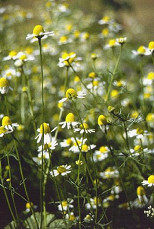
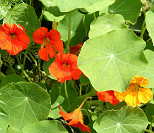

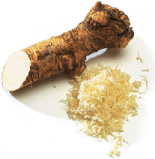
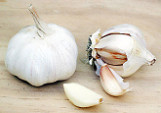
Herbal antibiotics can be found in: camomile [12], Indian cress [13], Sage leaves [14], horseradish [15], garlic [16], thyme [17]
The details say clearly that one should NOT take any antibiotic pills of pharma industry (Roche, Ciba, Sandoz, today's Novartis etc.) because the pills are destroying the gut flora and are weakening the immune system. And the herbal antibiotics have real advantages:
<[Doctor] Frank says that the advantages compared with the artificial produced antibiotics can be listed like this: Herbal antibiotics not only have got an effect against bacteria, but man times also against fungus and germs. It's a fact that 90% of all coughs are caused by virus, and classical antibiotics have no effect against them. And with herbal antibiotics there are no side effects or only little side effects, and there is no reaction of resistance known.
"Add to this the healing plants are fostering the healing of injuries, are inducing the forming of new tissue, and are detoxing the conjunctive tissue", says the doctor about more advantages of natural antibiotics. And as another side effect these plants give much vitamins, minerals, trace elements and other vital substances. But all in all these helpers of nature can be recommended only for the treatment of light or medium infections - can be treating infections of urinary passages or treating airways' diseases.
All plants from mustard family contain antibiotics as for example horse radish and almost all plants from lily family as for example garlic. According to doctor Frank, the effect inhibiting germs, virus and fungus has got it's cause because of the sulfur compounds and because of the essential oils of the plants.> [web07]
(original German:
<Die Vorteile gegenüber künstlich hergestellten Antibiotika liegen für Frank auf der Hand: Pflanzliche Antibiotika wirkten nicht nur gegen Bakterien, sondern häufig auch gegen Pilze und Viren. So würden 90 Prozent aller Erkältungen von Viren verursacht, so dass die klassischen Antibiotika hier ihre Wirkung verfehlten. Nebenwirkungen könnten gänzlich fehlen oder seien oftmals nur gering, und eine Resistenzbildung sei unbekannt.«Außerdem fördern die Heilpflanzen die Wundheilung, regen die Bildung von neuem Gewebe an und entgiften das Bindegewebe», zählt der Mediziner weitere Vorteile der natürlichen Antibiotika auf. Und ganz nebenbei versorgten sie den Körper mit Vitaminen, Mineralstoffen, Spurenelementen und anderen Vitalstoffen. Allerdings seien die Helfer aus der Natur nur zur Behandlung von leichten und mittelschweren Infektionen zu empfehlen - etwa bei Harnweginfektionen oder bei Erkrankungen der Luftwege.
Antibiotisch wirksame Stoffe beinhalten alle Kreuzblütler wie zum Beispiel Meerrettich und fast alle Liliengewächse wie etwa Knoblauch. Die keim-, viren- und pilzhemmmende Wirkung ist Frank zufolge meist auf die Schwefelverbindungen und ätherischen Öle der Pflanzen zurückzuführen.> [web07]
Well, and now everybody has got the task to change his/her kitchen installing the natural herbal antibiotics, and then simply less or no people will fall ill any more. It's so simple.
Chemistry is also inventing "combination products", because the "wonder" should be repeated (p.89).
[And of course there is NEVER any advice that there are natural herbal antibiotics. One can it also call a complete piss-take of the world wide society].
Antibiotics in feedstuff for a faster growth of the animals
And to top it all this pharma industry is also interfering in cattle breeding systems: Antibiotics in feedstuffs provoke a faster growth of the animals because there are no risks of diseases any more and prevention measures don't have to be observed any more.
-- the farmers and the governments believing in technique developments of "civilized world" mean that the result would be a faster animal production with a perfect health in one time, and this would be a true "wonder"
Antibiotics in feedstuffs: Resistances of bacteria are always increasing, so... [18]
-- but then the antibiotics in the meat get into the food chain, and persons eating meat in industrial states where agriculture is working with antibiotic feedstuffs is taking more and more antibiotics which are not at all needed, and therefore the resistance of bacteria in the human bodies is increasing on and on (p.90).
Antibiotics causing illnesses with children: allergy risk
Long term investigations with 3,000 children show: Antibiotic treatment with children between 0 and 2 years are causing an allergy risk of more than the double (p.90).
In: Farooqui, I.S. a.o.: Early Childhood infection and atopic disorder; In: Thorax 1998, 53 (11), p.927-932
[Conclusions:
There is a big necessity for a change to natural herbal antibiotics, and for certain illnesses the chemical antibiotic pills (from Roche, Sandoz, Ciba, today's Novartis etc.) should be completely prohibited and used only in the emergency case. Memorize the following list of plants with herbal antibiotics:
-- all plants from mustard family
-- almost all plants from lily family
-- camomile (Matricaria chamomilla)
-- Indian cress (Tropaeolum)
-- sage (Salvia)
-- horseradish (Armoracia rusticana)
-- garlic (Allium sativum)
-- thyme (Thymus) [web06].





Herbal antibiotics can be found in: camomile [12], Indian cress [13], Sage leaves [14], horseradish [15], garlic [16], thyme [17]
10.
Research for disinfecting agents: Alexander Fleming finds, Florey and Chain are producing Penicillin
Biological, antibacterial agents - new "medicaments" and procedures - new diseases
Biological, antibacterial agents are
-- in the juice of garlic
-- in the extract of thimble
-- in tea tree oil etc. (p.88).
Until 1945, normal "medicine" is developing the following "medicaments":
-- Digoxin (a heart cure with the agent of thimble)
-- some vaccines
-- Salvarsan (in some kind against syphilis) (p.90)
-- some vitamins are detected
-- and the hormones thyroxine and insulin are detected (p.91).
But at the same time developing "civilization" since 1945 there are new diseases coming up which never had existed before:
-- gastric ulcer [because of too much stress]
-- heart attack [because of too less movement in life]
-- lung cancer [because of smoking or passive smoking] a.o. (p.91).
Normal "medicine" is looking for causes of these diseases without any success and the doctors believe yet since Pasteur that there would be a biologic agent against bacteria (p.91).
Work of Alexander Fleming in London - accidentally he finds penicillin
-- Fleming resigns to chemotherapy
-- he means that only the organism itself could heal an infection (p.91)
-- in 1921 he detects accidentally that there are enzymes with strong effect in nasal mucus and in lacrimal fluid, because somebody is coughing and some bacteria cultures are decomposing then (p.91-92).
Fleming means that this must be an agent of the immune system and calls it "Lysozyme" (p.92).
Alexander Fleming in the laboratory [19]
Alexander Fleming was a Scottish bacteriologist (born in 1881 in Lochfield - died in 1955 in London). He studied medicine in London at St. Mary's Hospital Medical School in Paddington district, and after his diploma in 1906 he stayed in the institute, got to be co-chairman in 1921 and it's director in 1946. At London University he had a chair in bacteriology from 1928 to 1948 [web09].
In 1921 Fleming isolated the enzyme Lysozyme which can destroy bacteria. In September 1928 he detected accidentally mold fungus of the kind of "penicillium" in his staphylococci cultures. The bacteria had been killed by the molds, and this was the detection of the penicillin antibiotic.
Honors
-- Fleming is honored doctor of 12 universities in Europe and in the "USA"
-- Fleming gets to be a "commander" of French Legion of Honor
-- Fleming gets to be a honored doctor of Edinburgh University.
In 1944 Fleming gets the title of nobility.
In 1945 he gets the Nobel Prize for Physiology or Medicine for the detection of penicillin antibiotic.
Fleming always was a Free Mason and died on 11 March 1955 in London suffering a heart attack. He was buried in the London Saint Paul's Cathedral [web09].
This was the summary, and now details follow:
Summer 1928
Holiday of Fleming and the fungus event
In summer 1928 Fleming has not got any good result against infections and takes a vacation, but he forgets to put his Petri dishes with his bacteria cultures in the fridge. After his return one of the stophylococci cultures is overgrown with a mold fungus, and this mold fungus has harmed the bacteria culture: around the mold the bacteria culture is dissolved. The mold fungus' origin is the laboratory of the plant scientist C.J La-Touche, one floor more downstairs (p.92).
Now the weather in London played a decisive role:
-- first the mold fungus could grow during cool weather
-- and then the bacteria has grown during warm weather, and then the bacteria was killed by the mold fungus (p.92-93).
Now the liquid of the mold fungus is extracted and defined as "Penicillin", absolutely accidental. Experiments show that the mold poison "Penicillin" also is effective
-- against gonococci
-- against meningococci.
-- against the diphtheria bacillus and against many more bacteria, without harming the white blood cells of the immune system's defense. The effect is strong and sure (p.93).
1929
Fleming's Penicillin report is not pursued
In 1929 Fleming publishes his research report about penicillin, but for a strange reason the mold fungus cannot be reproduced in other laboratories. Fleming is closing the topic and is making research with other bacteria (p.93).
The beginning of industrial production of bacteria killing penicillin 1939-1945
Only in 1939 the two biochemists Howard Florey and Ernst Chain are working with penicillin again. Florey is an Australian in England, and Ernst Chain is a German Jew who had to flee from Nazi regime. Both are working with the mold fungus agent penicillin now - in Oxford.

Howard Florey, portrait [20]
Howard Florey (1898-1968) was studying in Adelaide University 1917-1921, then was Rhodes scholar in England at Magdalen College in Oxford and made a Master degree, and in 1927 he got a Doctor title at Cambridge University. Then followed works in the "USA" and in Cambridge. In 1931 he was professor for pathology at Sheffield University, and since 1935 he was professor in Oxford. Since 1938 after having read Flemings works about the penicillin mold fungus, he began with the development of a mass production of penicillin, together with Ernst Boris Chain and Norman Heatley. Since 1941 Florey got many honorary memberships and rewards, got to be knight in 1944, Nobel Prize in 1945, Baron title in 1965, was a member in the Order of Merit in 1965. And in 2009 also he got a "moon crater" [web10].
[Well, everybody knows that nobody was on the moon and all maps are pure fantasy].
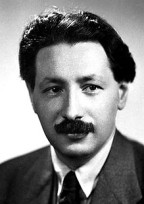
Ernst Boris Chain, portrait [21]
Ernst Boris Chain was born in 1906 in Berlin as a son of a Russian Jewish chemistry plant manufacturer, studied chemistry and medicine in Berlin up to a Dr. title at Friedrich Wilhelm University in 1930 and then he was working at Charité hospital busy with enzyme research. In April 1933 after change of power by Hitler he emigrated to England and continued his research in Cambridge, since 1945 as a chemist at Oxford University in the department of a pathologist called Howard Walter Florey. In 1939 he got the English passport.
Chain and Florey succeeded in stabilizing the instable penicillin, and the animal tests could prove it's antibacterial effect. Then the chemical structure was isolated and penicillin and other antibiotics were produced. In 1945 he got with Fleming and Florey the Nobel Prize for Medicine and Physiology. In 1946 he got Pasteur Medal, in 1949 he got a Fellow membership in Royal Society of London. In 1949 he also became a director of <Research Center for Chemical Microbiology at Superior Institute of Sanitá in Rome>. In 1954 he got Paul Ehrlich Prize. In 1961 he became a professor (since 1973 Senior Research Fellow and Prof. em.) at Imperial College of Science in London, and in 1962 he got the Italian Marotta Medal. He also developed new methods and devices for biochemical microanalytics. He died in 1979 in Castlebar in Ireland [web11].
Ernst Chain detected
-- chemical formula of Lysozyme
-- chemical formula of Penicillin which is not an enzyme (p.94) but is a low molecular substance with a big chemical instability (p.94-95)
-- but the production of this fungus juice also was a problem for Chain and Florey (p.94).
In 1940 penicillin production began in Oxford under war conditions. Chain cleans the penicillin. Laboratory test is very effective and mice are not intoxicated, but the effect against bacteria is 100%. But now the research funds during war times are not very high, and the industrial bosses in these times are hardly interested in medicine. But Florey decides now to put his priority on penicillin and is changing the whole university department for the penicillin production (p.95). This priority setting is a poker game because a failure is yet possible (p.95-96).
Mold fungus and penicillin are produced in masses with the most primitive means. Penicillin mold fungus is produced on toilet bedpans, the liquid is stored in milk bottles. There follow first successful treatments with ill persons in the "USA", then also in Great Britain (p.96).
In 1944 finally penicillin is used in the military hospitals of Second World War (p.97).
[Remark: Nazi side rejects the use of penicillin because this would be a product of the "enemy". At the end herbal antibiotics are recommended].
| Teilen
/ share: |
Facebook |
|
Twitter |
|
|
|
Sources
[web01] Horse blood against diphtheria: http://www.sciencephoto.com/media/300984/enlarge
[web02] Diphtheria: http://de.wikipedia.org/wiki/Diphtherie
[web03] Syphilis: http://de.wikipedia.org/wiki/Syphilis
[web04] Paul Ehrlich: http://de.wikipedia.org/wiki/Paul_Ehrlich
[web05] garlic is antibiotic: http://www.zentrum-der-gesundheit.de/knoblauch.html
[web06] natural antibiotics: Focus: http://www.focus.de/gesundheit/ratgeber/erkaeltung/tid-12543/sanfte-therapie-breitbandantibiotika-aus-der-natur_aid_348263.html
[web07] natural antibiotics: news.de: http://www.news.de/gesundheit/796092365/geheimwaffen-aus-der-natur/1/
[web08] mustard family: http://de.wikipedia.org/wiki/Kreuzbl%C3%BCtengew%C3%A4chse
[web09] Alexander Fleming: http://de.wikipedia.org/wiki/Alexander_Fleming
[web10] Howard Florey: http://de.wikipedia.org/wiki/Howard_Walter_Florey
[web11] Ernst Boris Chain: http://de.wikipedia.org/wiki/Ernst_Boris_Chain
Photo sources
-- injection into a leg: http://www.pw1.tsn.at/schueler/pirpamer/pirpamer.htm
-- threatening injection: http://www.planet-wissen.de/pw/showdocument,,,,,,,,,,,,,,,,,,,2236A4DC833B45F2E0440003BA5E0921,,,.html
-- fat addiction: http://www.einslive.de/magazin/specials/2007/09/bier_abc.jsp?pbild=2
-- breast cancer, X-ray photo: http://members.aon.at/manfreda/Brustkrebs-Vorsorge_Mammo.htm
-- operation: http://www.sporttrauma.org/
-- pills without end: http://www.fr-online.de/in_und_ausland/wissen_und_bildung/aktuell/?em_cnt=1679115&em_src=649722&em_ivw=fr_wissen
-- inhalator for insulin: http://www.cbc.ca/health/story/2006/07/13/insulin-inhaled.html
-- Medicine Cartel, cover: http://www.amazon.de/Das-Medizinkartell-Kurt-Langbein/dp/3492044077
[1] Paul Ehrlich, portrait: http://de.wikipedia.org/wiki/Paul_Ehrlich
[2] Bayer, Aspirin: http://www.globalpackagegallery.com/main.php/v/OTC_Medicine/headache/VR-0408_008_1.jpg.html
[3] production of diphtheria serum with horse blood: http://www.sciencephoto.com/media/300984/enlarge
[4] girl with swollen neck by diphtheria: http://de.wikipedia.org/wiki/Diphtherie
[5] Emil von Behring, portrait: http://de.wikipedia.org/wiki/Emil_von_Behring
[6] Paul Ehrlich in his working room at about 1900: http://www.aref.de/kalenderblatt/2010/09_heilung-von-syphilis_paul-ehrlich_1905.php
[7] Salvarsan by Hoechst: http://www.paul-ehrlich.de/Research/research.htm
[8] Neosalvarsan by Hoechst: http://www.volksapotheke.ch/2010/Meilensteine%20der%20Pharmazie/Salvarsan.html
[9] syphilis ulceration at a hand: http://www.webmd.com/sexual-conditions/guide/syphilis
[10] syphilis ulceration at a foot and leg: http://www.greatdreams.com/syphilis.htm
[11] antibiotic: http://www.ugiwaza.org/2012/07/12/krankenstand/
[12] herbal antibiotic: camomile: http://www.heilpflanzen-suchmaschine.de/kamille/kamille_bilder.shtml
[13] herbal antibiotic: Indian cress: http://suite101.de/view_image.cfm/313611
[14] herbal antibiotic: sage leaves: http://www.heilkraeuter.de/lexikon/salbei.htm
[15] herbal antibiotic: horse radish: http://www.apotheken-umschau.de/heilpflanzen/meerrettich
[16] herbal antibiotic: garlic: http://de.wikipedia.org/wiki/Knoblauch
[17] herbal antibiotic: thyme: http://olivenoelblog.com/fruehling-laesst-sein-blaues-band/thymian/
[18] antibiotics in feedstuffs: http://news.de.msn.com/politik/politik.aspx?cp-documentid=155879319
[19] Alexander Fleming in his laboratory: http://www.guardian.co.uk/public-leaders-network/blog/2011/sep/01/design-public-services
[20] Howard Florey, portrait: http://en.wikipedia.org/wiki/Howard_Florey
[21] Ernst Boris Chain, portrait: http://en.wikipedia.org/wiki/Ernst_Boris_Chain

